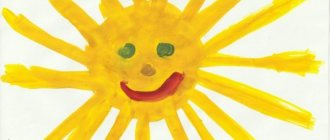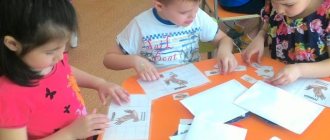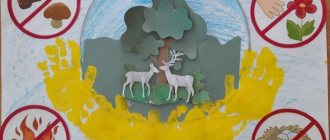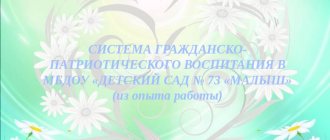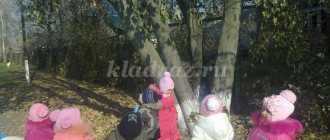The work “Aesthetic education of preschool children.” Author: Khabichaeva Fatima Khasanbievna
“Artistic and aesthetic development of preschool children”
Childhood is the most favorable period for the development of children's creative abilities.
From the early years of life, a child involuntarily reaches out to everything bright and attractive, rejoices in shiny toys, colorful flowers and objects.
In the process of aesthetic education, children move from an inexplicable reaction to everything bright and beautiful to a conscious perception of beauty.
The educational direction “Artistic and Aesthetic Development” involves: developing prerequisites for understanding the value of works of art (verbal, musical, visual), forming an aesthetic attitude towards the world around us: forming elementary ideas about types of art; perception of music, fiction, folklore; implementation of independent creative activities of children (visual, constructive-model, musical, etc.).
One of the important conditions for the implementation of a system of aesthetic art education in a preschool institution is the organization of a subject-development environment.
The subject-development environment in a preschool educational institution promotes cognitive development, the development of interest in the world of art, skills in visual, musical, theatrical activities, and creativity.
And for this purpose, conditions have been created in each age group for the comprehensive development of the individual. In the corners there are various materials, attributes, manuals and games. Technical teaching aids are used. Reception areas in group rooms and corridors are effectively used: where exhibitions of photographs, children’s drawings, and crafts made from natural materials are displayed on stands.
Education plays an important role in shaping the aesthetic taste of children.
Children learn to recognize and love real works of art that are accessible to their age.
The skills and abilities that preschoolers receive in aesthetic education lessons are reflected in play activities. Children develop an interest in joint creative activities through theatrical performances. And theatrical activities, in turn, encourage children to improvise using means of expression (facial expressions, gestures, movements).
Preschool age is the most sensitive for the formation of artistic and aesthetic culture. Aesthetic education is designed to intensify the activity of the preschooler himself, since it is important to develop his ability to perceive beauty and create it with his own hands. Introducing a child to culture is educational in nature, develops creative abilities, forms artistic taste, and introduces aesthetic values.
The aesthetic development of a child in kindergarten is daily painstaking work in all types of creative activities of both the preschooler himself and the adults around him, specialists of various levels (educator, music director, etc.). In addition to improving natural abilities in the field of various types of artistic activity, prospects for the comprehensive development of personal qualities open up for the child, the range of his knowledge about the world and nature expands, and his thoughts and feelings are ennobled.
Summary of a lesson on aesthetic education for grades 7-9
Summary of a lesson on aesthetic education “Russian forest as a song for the soul...”
Summary of a lesson on aesthetic education “Russian forest as a song for the soul” for children 13-15 years old with disabilities.
Goal: to cultivate an aesthetic attitude towards nature, to forest resources, to help see their beauty Objectives: 1. To introduce the diversity of natural resources of Russia, to cultivate the desire to preserve and enhance the beauty of nature 2. To increase children’s interest in nature, developing their ability to admire and be enchanted by its beauty .
3. to form and correct existing skills to listen carefully, without interrupting others, to form coherent speech 4. Enrich and expand vocabulary (crimson, painted, azure, lilac, motley, etc.) 5. Develop logical thinking, auditory and visual attention 6. Foster a sense of pride in your country. Progress of the lesson.
Music is playing My native country is wide There are many forests, fields and rivers in it I don’t know another country like this Where a person breathes so freely... Guys, you all know these words, you, of course, know what a huge country we live in. Tell me, what is it called? Russia. That's right, our vast country is called Russia. And no country in the world has such a rich and diverse nature as ours. It is very cold in the North, there is ice, icebergs and eternal snow,
in the south there are hot deserts,
In the middle zone, nature is rich and varied. One of the riches of our nature is forests. Look what kind of forests there are.
Coniferous. What trees grow there? (Pines, spruces,) Deciduous. Linden, maple, birch, oak Mixed. (Both) And now we will check if you are attentive listeners and distribute the names of the trees according to their place of growth. Forests Deciduous Coniferous (children hang pictures of trees on the board) See what a variety of trees and colors reign in the forest! Let's listen to the poem The forest, as if we were rubbing a painted one Lilac, gold, crimson A cheerful motley wall Stands above a bright clearing Birches with yellow carvings Glisten in the blue azure Like mice, the Christmas trees darken Here and there in the through foliage Clearances in the sky from the window The forest smells of oak and pine Over the summer it dried up from the sun, and a very quiet widow enters her motley mansion. Now you have listened to such a magical poem, but maybe the meanings of some words are unknown to you? “Purple, gold, crimson” Think about what these words mean? (Children’s answers) (The children’s reasoning is followed by a hint on the screen.) At the very beginning of the lesson, you said that deciduous trees have leaves, coniferous trees have needles, let’s now play the game “Which tree is the leaf from?” I name the tree, and you say the correct name of its leaf (maple leaf - maple, etc.) Oak leaf - oak, pine needles - pine, willow leaf - willow, cedar cone - cedar, poplar leaf - poplar, aspen leaf - aspen, linden leaf - linden, spruce cone - spruce, birch leaf - birch. That's right, guys, birch.
Birch is Russia's favorite tree, it is its symbol. Birch trees can be found in the forest, in the park, and in the school yard. . Our people love the green beauty for her beauty. It grows in all corners of our vast homeland. Birch can be found even in places that seem unsuitable for plants. In the south there are birches as big as masts,
and in the north there are dwarf ones, the size of a child.
But all birches have very unusual bark. What is unusual about birch bark? (Answers). Birch is called white-trunked birch for its bark. White bark is called birch bark. Birch bark is a protective layer of wood. It protects against water and harmful human influences. But in the white bark - birch bark there are vents: black lines. They are called lentils, and the birch tree breathes through them.
The Russian people dedicated a lot of poems to this tree. - Listen, what beautiful words can be said about the birch tree: “Like a Russian maiden, she stands silent. »
And now we will listen to an excerpt from another poem The white birch tree under my window Covered with snow, like silver On the fluffy branches with a snowy border The tassels have blossomed with a white fringe And the birch tree stands in sleepy silence And the snowflakes burn in a golden fire... Guys, we just listened to a winter birch fairy tale ..
And in the spring, when the trees “wake up” and sap flow begins, the birch tree secretes tasty sap, which is drunk to improve health.
What is it called? birch. And now you and I will try it ourselves and treat it to our guests. Children taste birch sap and treat guests. You see, guys, what sweet moments Russian nature can give us, how much pleasure and pleasant moments a person experiences when communicating with it. This should never be forgotten. Let's talk a little more about the riches of the forest, its inhabitants, its sounds and colors. In the spring, White sheds tears...(BIRCH) If the breeze blows Its leaf will tremble The breeze is not at all strong But the leaf...(ASPEEN) trembles. This tree will come to every home on New Year's Eve. Green and prickly It’s called...(THREE) Children grow up on oak branches Little mischievous ones They wear carved hats (ACORNS) So many trees in the forest! Each tree sounds differently, either rustling or creaking. All these are sounds of the forest. Poem (Romantsova Liza) Sit on a stone under the forest pine, listen to the silence The brook babbles and babbles That the path is far, far A pine cone has fallen, a branch has creaked A heavy beetle is buzzing, buzzing The foliage is telling dreams You hear the voice of silence... Let's go with you too, without leaving from class, let's also listen to the forest silence...What is it like? Unusual, wonderful, magical. (Relaxation to the sounds of the forest 2 min) The forest rustles, sings, rings, buzzes. Birds give a wonderful concert in the forest. Animal voices are their conversation. And it is so important not to interfere with this conversation, because if we make noise in the forest, listen to loud music, we may not hear birds singing, butterflies fluttering, and animals will not be able to tell each other something important, a frightened bird will be afraid to fly up to the nest, and the chicks will remain hungry. That is why it is so important to walk through the forest carefully and carefully, because it is so wonderful to enjoy the beauty of our native nature, the green lawn at the forest edge, the ringing singing of birds, the rainbow fluttering of butterflies and dragonflies. It’s not difficult - without running, without shouting and hooting, but quietly, quietly, calmly walk along the forest path. Please don't forget about this. Let's check how you remember the rules of conduct in the forest. A game of attention. I will give you examples of behavior in the forest, and you, if you agree, will say “This is me, this is me, these are all my friends, and if not, then remain silent - Who walks along the path and does not step on the bugs? -We don’t break twigs when we walk through the forest -We took the tape recorder into the woods and drowned out the birds’ voices -We will find an anthill, observe and leave. - I saw a fly agaric, I’m passing by, friends - We’ll take the dogs into the forest, the birds will be calmer in it. -Who collects lingonberries and pulls out the bush by the roots? Well done boys. Are there any forest hooligans in our group? No, and that's good. A person should treat forest resources with care, because it is not only beauty and relaxation for the soul, but also great benefits. Trees grow in the forest, from which paper is produced for books, albums, and notebooks. Mushrooms and berries also grow in the forest, and numerous animals and insects live. Let's talk about this. What mushrooms grow in the forest? EDICABLE and INEDIBLE White fly agarics, boletus, toadstool, false honey mushrooms Chanterelles, Russula You need to correctly use the arrows to distribute the names of mushrooms into groups. What wild berries do you know? Strawberries, raspberries, cranberries, blueberries, lingonberries Guys, how are wild berries used? Dry, freeze, make jam, juices, compotes. What kind of jam do you like? You see, guys, how much joy and pleasure nature gives us! Forest is the main wealth of Russia. It gives a person clean air, berries, mushrooms, and medicinal plants. The forest is a home for a huge number of animals, insects, and birds. What forest inhabitants do you know? (FOX, HARE, BEAR, WOLF, SQUIRREL, HEDGEHOG) Guess who we are talking about now. He runs and winds through the forest. By summer he changes his fur coat. In the snow he is invisible. The wolf and the fox are offended... (Hare) I jump back and forth Through the trees deftly Never empty I have a pantry... (Squirrel) Touching the grass with thorns A handsome man walks through the forest Walks boldly and easily With his horns spread wide... (Moose) Day and night prowls through the forest Day and night looking for prey He walks, he wanders silently His gray ears stick up…. (Wolf) Without a path without roads A gray ball is rolling It is completely covered in sharp needles Because it is…. (Hedgehog) Sleeps in winter, stirs up hives in summer (Bear); Smaller than a tiger, larger than a cat, with horns above the ears, meek in appearance, but don’t believe it, this beast is terrible in anger (Lynx); Water craftsmen build a house without an axe, a house from brushwood and mud and good dams (beavers); He wears his antlers like a royal crown, eats lichen, green moss, loves snowy meadows. (Deer); Cunning cheat, red head, fluffy tail - beauty! What is her name...(Fox); near the oak tree he (Boar) was busily digging the ground with his sharp snout; He will never put anything unwashed into his mouth and you will be like a baby... (Raccoon); This predatory animal has luxurious striped fur, it walks quietly, like the wind, lives in nature, like a king (Tiger). Yes, guys, indeed, the forest is a big home for all living things. Every animal in the forest has its own home. What are the names of the houses of forest dwellers? Who lives where? Let's try to give the correct names to the houses of the forest inhabitants. Squirrel - in a hollow
bear - in a den,
fox - in the hole,
the wolf is in the lair,
bird - in the nest
ant - in an anthill,
Let's listen to the poem "Everyone has their own home." 1. A fox in a remote forest has a hole - a reliable home. Snowstorms are not scary in winter. A squirrel in a hollow in a spruce tree. Under the bushes a prickly hedgehog rakes leaves in a heap. From branches, roots, bark. Beavers make huts. A clubfoot sleeps in a den. Until spring, he sucks his paw. Everyone has your home, everyone is warm and comfortable in it. In the forest, everyone has their own home, and for humans, such a home is nature, it is considered our home. And it depends on you and me what kind of house we and our children will live in. Man is also nature. He is also sunset and sunrise. And there are four seasons in him. And there is a special course of music in him. Trees, grass, flowers and birds do not always know how to defend themselves. If they are destroyed, we will be left alone on the planet. What does a man without grass and birds mean? And without love for the buzzing bee? Without a crane over a coniferous thicket Without pretty fox faces? When will he finally understand, Digging into dead rocks, That man is the crown of nature And without nature we are finished? On earth we live with you. There is no more beautiful land than our native land. So let's take care and love. Don't ruin her beauty
Well, let's summarize. What we were talking about? We listened to the sounds of the forest and the singing of birds about Russia, about the diversity and richness of its nature, about one of the main riches - the Russian forest, its colors, inhabitants, plants. You see, guys, how many mysteries and secrets are hidden in the rich Russian forest? And at the end of our lesson, I would like to offer you a short video clip about the colors of the forest. Let’s admire its magic once again. (video “Colors of the Forest”) I hope all this gave you at least a little pleasure and allowed you to sincerely admire the natural beauty once again. Thank you for your attention!
We recommend watching:
Scenario of the educational program “Cities of Russia” for primary and secondary school age Scenario of a competitive program for career guidance, grades 7-9 Extracurricular event for schoolchildren. Journey to the land of health Extra-curricular activity for schoolchildren
Similar articles:
Intellectual game for schoolchildren “Knowledge Auction”
Ecological game. Script for high school students
Summary of an extracurricular activity for children 9-12 years old “Intuition. Circle of professions"
Extracurricular event against AIDS
Extracurricular activity. Drug addiction prevention
